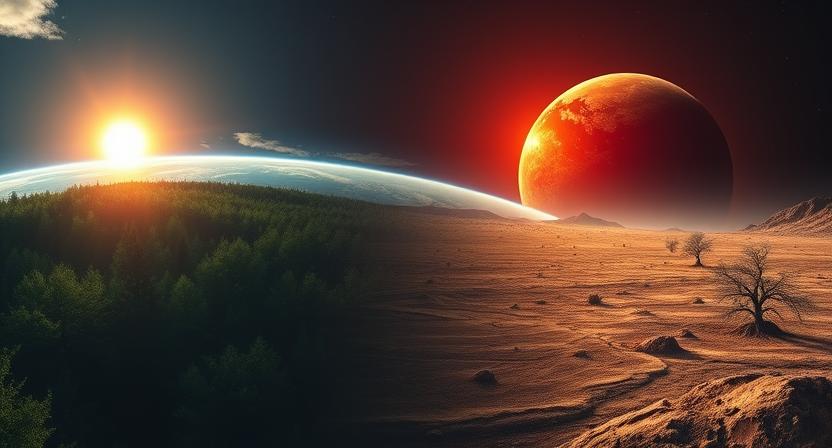Earth’s Atmosphere Oxygen Decline: The Real Cause of the Planet’s Distant Demise
While popular doomsday scenarios often feature climate disasters, asteroid strikes, or nuclear wars, the true end of Earth as a host for complex life may come quietly — through the gradual decline of oxygen in Earth’s atmosphere. According to a compelling study from Toho University in Japan, with support from NASA’s planetary modeling, the Earth’s atmosphere will undergo a slow but irreversible shift that will eliminate breathable oxygen — and along with it, most forms of life.
Table of Contents
A Billion-Year Countdown Begins: Why Oxygen Is the Key to Earth’s Future
The Role of the Sun in Atmospheric Change
Scientists have long known that stars like our Sun gradually grow brighter over time. The Toho University study used advanced atmospheric and climate models to simulate how this increase in solar energy will affect the Earth’s biosphere. The models project that within the next 1 billion years, the Sun will shine so intensely that it will disrupt Earth’s atmospheric balance.
As a result, Earth’s carbon cycle — a crucial process that supports plant life and oxygen production — will begin to break down. With plants unable to survive the rising heat, oxygen levels in the atmosphere will begin to fall. The decline of atmospheric oxygen will ultimately push Earth back into a pre-oxygen state, resembling the early days of our planet over 2.5 billion years ago.
How Earth’s Atmosphere Oxygen Decline Will Unfold
Stage by Stage Breakdown
- Increased Solar Radiation: The Sun’s brightness continues to rise over geological timescales, increasing Earth’s surface temperature.
- Disruption of the Carbon Cycle: Plants lose their ability to photosynthesize effectively in hotter, drier conditions.
- Reduced Oxygen Production: As plant life declines, so does the oxygen it generates. The atmosphere begins to shift toward lower oxygen and higher levels of methane and carbon dioxide.
- Mass Extinction of Aerobic Life: Species that rely on oxygen — including humans, animals, and most plants — will slowly go extinct.
- Survival of Anaerobic Microbes: Only microbial life that doesn’t require oxygen may survive in isolated, extreme environments.
A Return to Earth’s Ancient Atmosphere
The Earth’s atmosphere oxygen decline will not be a cataclysmic collapse, but a slow fade into a state last seen billions of years ago. The skies may still be blue, and the planet may still spin, but complex life will vanish. The transformation will take place over tens of millions of years, leaving behind a quiet world where only the hardiest microscopic organisms remain.
How This Differs from Other “End of the World” Theories
Why Oxygen Loss Is the Most Inevitable Long-Term Threat
- Climate Change: A very real threat today, but it operates on human timescales. It may devastate ecosystems, but won’t erase oxygen.
- Asteroid Impacts: Rare and sudden, these events can cause mass extinctions but are unlikely to eliminate all life or oxygen.
- Nuclear War: Catastrophic on a global scale, but survivable by microorganisms and many oxygen-generating organisms.
- Pandemics: Deadly to populations, but not capable of transforming the chemical makeup of Earth’s atmosphere.
Unlike these, the oxygen decline is a natural, astrophysical inevitability, directly tied to the life cycle of our Sun. It is a process that cannot be stopped, only understood.
What Happens After the Oxygen Is Gone?
Once the Earth’s atmosphere oxygen levels fall below survivable thresholds, aerobic organisms will die off. The forests will wither, animals will disappear, and eventually, all complex multicellular life will come to an end.
Earth may still have geological activity — volcanoes, earthquakes, and ocean movements — but biologically, it will enter a quiet phase. The only possible survivors will be anaerobic bacteria, similar to those that thrived before Earth developed an oxygen-rich atmosphere.
And in a few more billion years, as the Sun transforms into a red giant, Earth will be further scorched or even consumed by the expanding star — long after its breathable atmosphere has vanished.
Should Humanity Worry About Earth’s Atmosphere Oxygen Decline?
Not in Our Lifetimes — But It Puts Things in Perspective
This is not an immediate concern. The oxygen decline timeline spans a billion years, far beyond the scope of any civilization, nation, or species currently alive. However, the study offers a humbling reminder: even the very air we breathe has an expiration date. The decline of oxygen in Earth’s atmosphere is written into the laws of physics and stellar evolution.
Rather than worry about this distant future, scientists and environmentalists encourage us to focus on more pressing issues: preserving biodiversity, combating climate change, and sustaining Earth’s biosphere for future generations.
A Closing Reflection on Our Place in Time
The eventual decline of atmospheric oxygen reveals how fragile and temporary our existence truly is. All of Earth’s beauty — from green forests to soaring birds — depends on a narrow band of gases that will one day fade away. Understanding this long-term fate doesn’t demand panic, but awe. It situates human life within the vast, slow rhythm of cosmic evolution — and challenges us to make the most of our time in Earth’s breathable chapter.
Would you like a visual timeline of Earth’s oxygen decline and solar evolution?
